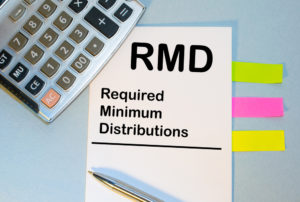 RMDs, or Required Minimum Distributions, are withdrawals that are required by the IRS each year out of your traditional retirement accounts like 401(k)s and IRAs starting at age 72. The money that you have to take out annually by December 31st at midnight is taxed based on your income tax rate for that tax year.
RMDs, or Required Minimum Distributions, are withdrawals that are required by the IRS each year out of your traditional retirement accounts like 401(k)s and IRAs starting at age 72. The money that you have to take out annually by December 31st at midnight is taxed based on your income tax rate for that tax year.
Some retirees forget about RMDs when planning for retirement, and don’t realize how big the tax bite may be for them. This year, because of the pandemic, the CARES Act suspended the RMD for the 2020 tax year in an effort to help retirees avoid withdrawing money from accounts when the market was down.
(An RMD is calculated based on the closing balance of the account at the end of the previous year. When the markets drop significantly, the RMD represents a much higher percentage of a diminished portfolio and that reduces the ability to recover from big losses.)
In 2021, the RMD will be back. As an example, a 75-year-old man with a traditional IRA worth $100,000 will have to withdraw $4,367 this year.
Roth 401(k) Plans
Roth 401(k) plans, which are funded with after-tax dollars, are subject to the same RMD rules that traditional 401(k) and IRA plans are. The amounts are calculated using the same IRS life expectancy tables and account holders must begin taking them after they turn 72. (One exception is if you continue working after age 72 for the company that sponsors the plan and you don’t own more than 50% of the company.)
The difference is that Roth 401(k) withdrawals are usually not taxed.
You can avoid taking the minimum distributions entirely by rolling a Roth 401(k) into a personal Roth IRA, which is not subject to RMD rules.
2020 RMDs Without Penalty, But With Taxes
As part of the CARES Act, the IRS allowed COVID-related withdrawals from traditional retirement plans up to $100,000 without penalty in 2020 for those who were impacted by the pandemic. Income taxes were due on those withdrawals, which could be paid over a three-year period. Those who can afford to can pay the withdrawals back this year (or over a three-year period) can get the taxes back by filing amended tax returns.
Those Who Just Turned 72—It’s Complicated
The SECURE Act of 2019 raised the age when RMDs must begin to age 72. If you turned 70-1/2 in 2019, the old rules applied—your first RMD should have been due April 1st, 2020. However, because the CARES Act suspended RMDs, the new due date was April 1, 2021 for those individuals.
For retirees who turned 72 in 2020 or will turn 72 this year, you can take your RMD at any point in 2021, or even delay it up until April 1, 2022. But if you choose to delay it, you will owe two RMDs in 2022, which could put you into a higher tax bracket.
You should check with your tax professional before making decisions about RMDs, because there are strict rules about which accounts must be withdrawn from and stiff penalties for mistakes—to the tune of taxes owed plus an additional 50%!
To discuss your retirement plan, including RMDs, please call us. We are happy to discuss ideas with you and/or your tax professional. You can reach Financial Wealth Alliance in Deerfield, Illinois at 847.312.3454.
This article is provided for educational purposes only and its content should not be relied upon for tax advice. As always, check with your tax professional or attorney for specific tax advice related to your situation.
Source:
https://www.cnbc.com/2021/03/01/required-minimum-distributions-on-retirement-plans-are-back.html



 Polska wersja
Polska wersja